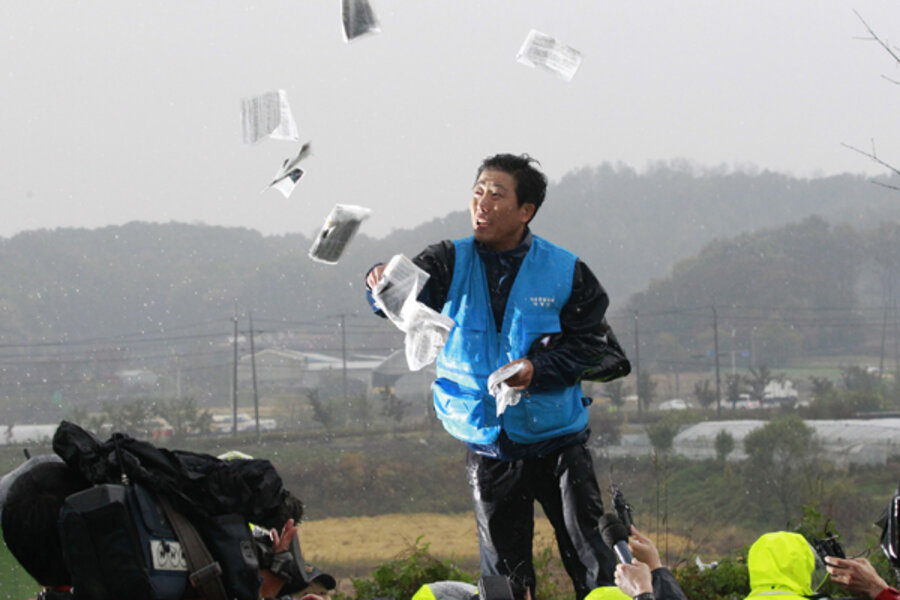South Korea blocks activists from air dropping leaflets over North
| Seoul, South Korea
South Korea backed down today in the face of North Korean threats of a “merciless military strike” if activists, mainly North Korean defectors, showed signs of making good on their plans to drop propaganda leaflets on the North.
Activists prepared today to launch balloons equipped with automatic timing devices that would enable them to drop tens of thousands of leaflets along with socks, dollar bills, and candy bars across the North Korean border.
However, the provincial police agency, acting on orders from Seoul, banned all civilian traffic to Imjin-gak (the site of memorials on South Korea's role in the Korean War and a large "Peace Bell" symbolizing the wish for peaceful reunification), about 35 miles north of Seoul, where the activists were gathering, in view of what it said were “safety concerns over North Korean warnings.”
The decision to keep the activists from firing the balloons contrasted with the hands-off policy that the government has previously followed in refusing to stop numerous leaflet drops in recent years. President Lee Myung-bak and other officials have often stated that they are powerless to stop activists from exercising their right as free citizens to make their views known in North Korea.
South Koreans appear sharply divided over the government’s apparent concession to North Korean threats.
“The government fears escalating the whole issue,” says Lee Sang-baek, an investment adviser, attending a conference here on the possibilities of reunification of North and South Korea. “Personally I think that’s too bad. They should not back down this way.”
Lee Sang-baek recognizes, though, that others strongly disagree. “The political opposition would say, ‘Stop doing anything silly',” he says.
A local resident, within artillery range of North Korea, strongly supports the government’s decision. “There’s no reason for angering them unnecessarily,” says Park Joong-gul. “We need to reduce confrontation. We don’t need any incidents.”
This time, the government was anxious to tamp down rising tensions between the two Koreas in the run-up to South Korea’s December presidential elections.
The stakes have risen in the aftermath of a surprise visit by the president last week to Yeonpyeong Island, the island in the Yellow Sea that North Korea shelled in November 2010, killing two South Korean marines and two civilians.
North Korea over the weekend again stated its refusal to recognize the “northern limit line” between a series of South Korean islands and North Korea’s southwestern coastline several miles away. South Korea refuses to permit North Korean vessels below the line – the root cause of a number of bloody shootouts in recent years.
In a rhetorical display to impress voters, the president said South Korea would retaliate directly against the North in the event of an attack on the islands. Kim Kwan-jin, South Korea’s defense minister, said the South would carry out a “perfect response” to any North Korean attack.
Under South Korea’s Constitution, President Lee cannot run for a second five-year term. But he is hoping the conservative Park Geun-hye, daughter of the late dictator Park Chung-hee, who was assassinated by his intelligence chief in 1979, will succeed him against a strong threat by two liberal candidates.
The North Korean threat posed the possibility of a tit-for-tat exchange after the North’s western command declared Imjin-gak and nearby Paju City were “targets of direct firing.” The command warned citizens to leave the area.
Mr. Park, the defector who had organized the leaflet campaign, said North Korea’s threats were “aimed at instigating division between people in the South.”





